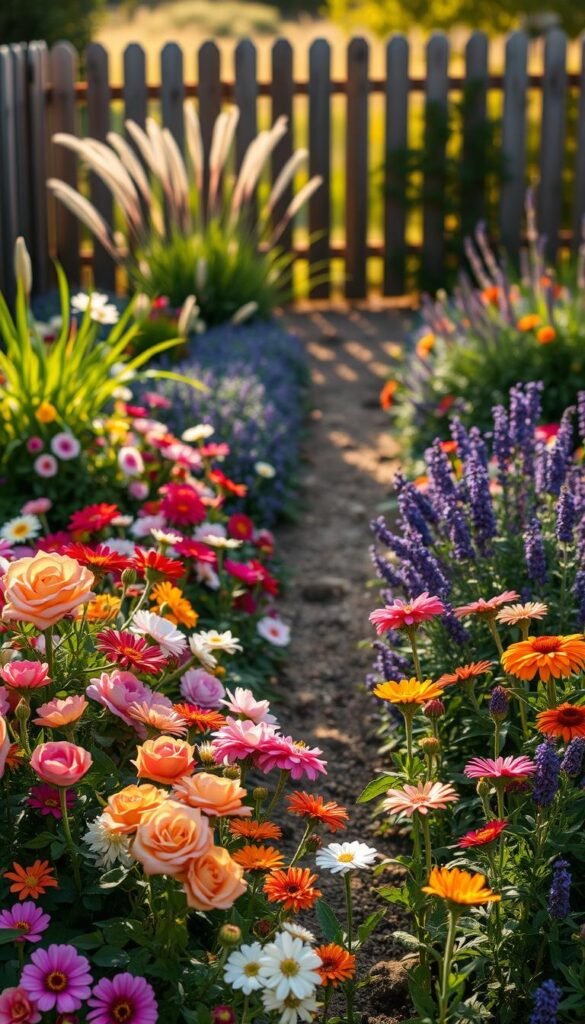Imagine stepping outside to gather armfuls of fresh blossoms without needing vast fields. Many growers are proving that space constraints don’t limit beauty or profit. Industry leaders like Erin Benzakein show how 1/40th of an acre can generate six-figure returns through smart planning.
This guide reveals how to work with your available area rather than against it. You’ll learn techniques used by professional growers to triple harvests without expanding footprints. Intensive planting strategies and seasonal rotation turn modest plots into continuous sources of color and fragrance.
Success stories aren’t limited to rural settings. Urban growers regularly earn $12,000+ annually through creative arrangements and local sales channels. Farmers markets and subscription services let you share nature’s artistry while building community connections.
We’ll explore how selecting the right varieties and timing plantings creates nonstop blooms from spring through frost. You’ll discover why focusing on quality over quantity often leads to better results, whether growing for personal joy or supplemental income.
Understanding the Space and Benefits for Your Flower Garden
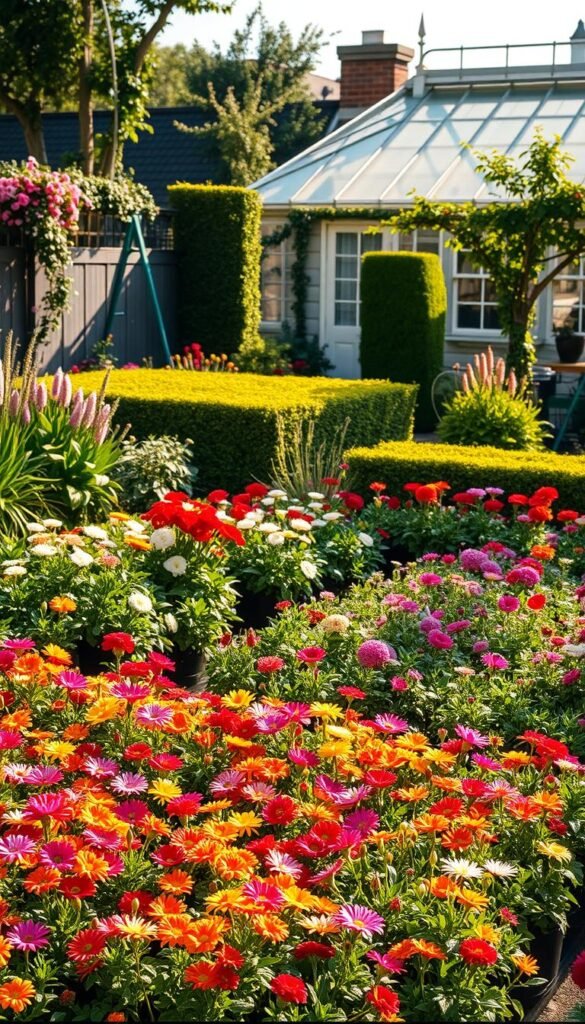
Transforming limited areas into productive zones starts with recognizing untapped potential. Many blooming enthusiasts discover their greatest successes come from refining existing plots rather than chasing more land. One grower learned this after moving plants to a larger site – only to watch them struggle. When relocated back to their original 300-square-foot plot, the same plants flourished, producing 40% more stems.
Working smarter where you are
Intensive cultivation beats expansion for beginners. A Vermont-based grower shares: “My failed experiment taught me that soil quality and attention matter more than acreage.” Compact spaces let you monitor moisture, pests, and growth patterns closely – advantages lost in sprawling setups.
Consider these productivity comparisons:
| Factor | Small Space | Large Plot |
|---|---|---|
| Weekly Management | 3-5 hours | 12-15 hours |
| Average Yield/Sq Ft | $8-12 | $2-4 |
| Plant Survival Rate | 92% | 68% |
Focusing on your current plot allows mastery of succession planting and microclimates. Urban growers often outearn rural counterparts by specializing in rare varieties that thrive in protected environments. Start by sketching your available area – even balcony corners can host 15-20 productive stems.
Successful arrangements begin with strategic spacing. Group flowers by height and harvest times, leaving room for staggered plantings. Record what works each season to build your personal success blueprint.
Designing Your Small Cut Flower Garden Layout: Maximizing Yields for Homegrown Bouquets
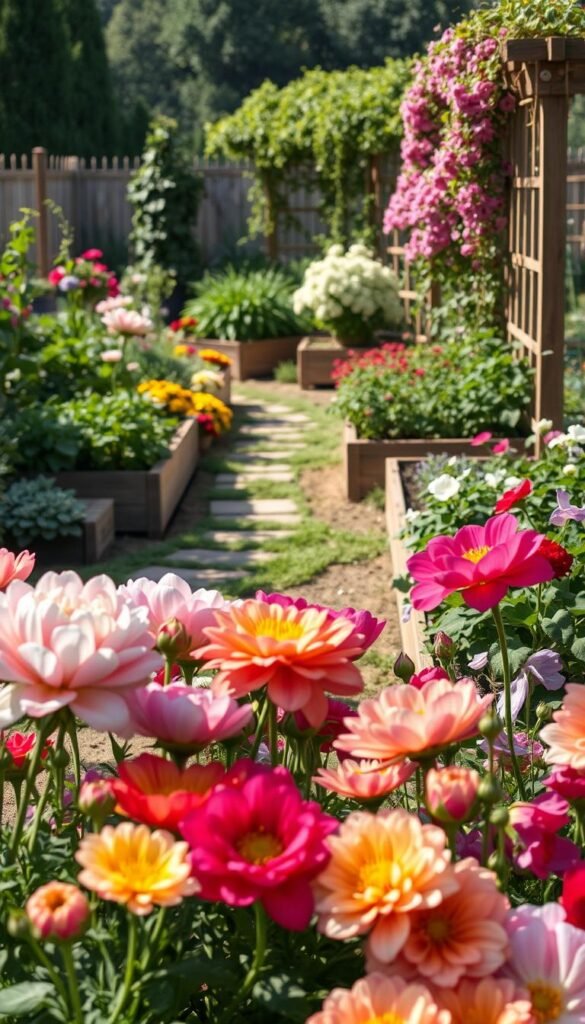
Crafting a thriving floral space begins with intentional design choices. Start by mapping your area’s natural contours—slopes, sunlight patterns, and wind protection matter more than you might think. A Michigan grower transformed her shaded backyard into a vibrant producer by aligning beds with morning light pockets.
Define clear edges using raised beds or low hedges. This creates visual structure while preventing soil erosion. Group zinnias with sun-loving dahlias, but keep moisture-dependent snapdragons separate. Companion planting reduces watering work and boosts plant health.
Three elements elevate every layout:
- 18″-wide pathways allowing knee-friendly access
- Vertical structures for climbing sweet peas or nasturtiums
- Strategic focal points like dwarf sunflowers
Rotate bloomers using this simple formula: Early tulips → summer cosmos → autumn chrysanthemums. One Oregon grower stretches her season by interplanting quick-growing calendula between slower peony bushes. “The orange petals hide dying foliage,” she notes.
Balance bold colors with airy fillers. Pair deep purple lisianthus with feathery ammi majus for arrangements that pop. Remember: Your design should serve both beauty and function—easy harvesting trumps rigid symmetry.
Planning Your Garden Beds and Walking Paths
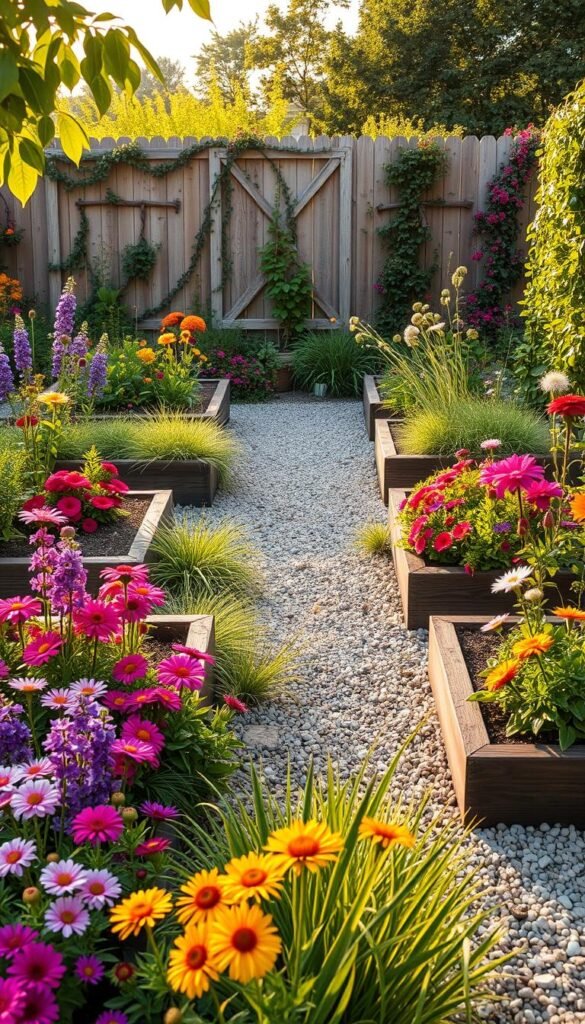
Efficient design turns compact plots into floral powerhouses. The secret lies in balancing growing zones with access routes – too narrow and you’ll struggle, too wide and you waste precious real estate. Professional growers swear by specific measurements that boost productivity while keeping maintenance manageable.
Optimizing bed dimensions and spacing
Forget the standard 30-inch beds you see at big nurseries. Successful small-scale growers use 42-inch wide beds paired with 18-inch pathways. This setup gives you 20% more planting rows than traditional layouts. A Pennsylvania farmer explains: “Our switch to wider beds added 150 stems per harvest without sacrificing accessibility.”
Compare these common configurations:
| Layout Type | Bed Width | Path Width | Stems/Sq Ft |
|---|---|---|---|
| Standard | 30″ | 12″ | 4.2 |
| Optimized | 42″ | 18″ | 6.8 |
Creating efficient access paths
Your pathways need to serve multiple purposes – kneeling space for planting, routes for watering cans, and harvest traffic flow. The magic number? 18 inches. This allows comfortable movement while maximizing your growing area. Rotate crops in adjacent beds to alternate high-maintenance and low-maintenance varieties, reducing pathway congestion.
Three path planning tips:
- Use permanent markers like bricks or low hedges
- Keep tool storage within 10 steps of any bed
- Angle beds north-south for even sun exposure
Remember: Your garden layout should evolve with experience. Track which bed shapes and path widths feel most natural during different seasons. Over time, you’ll develop a personalized system that makes every square foot count.
Crop Selection and Variety Tips for Vibrant Arrangements
Creating stunning bouquets starts with smart plant choices. Professional arrangers use strategic variety selection to maintain steady harvests and visual impact. Focus on multi-stem producers that thrive in tight spaces for better returns.
Choosing high-yield flower varieties
Prioritize plants offering multiple blooms per stem. Zinnias and cosmos outperform single-bloom types, yielding 15-20 stems weekly. Sweet peas climb vertically, producing 30+ fragrant blossoms per vine.
| Variety | Bloom Season | Stems per Plant | Use Case |
|---|---|---|---|
| Ranunculus | Spring | 8-12 | Focal blooms |
| Snapdragons | Summer | 15-20 | Vertical spikes |
| Amaranth | Fall | 25+ | Textural filler |
Incorporating color and texture in your garden
Group complementary colors in trios – try purple lisianthus with yellow marigolds and white gomphrena. For texture contrast, pair velvety celosia with wispy cosmos. Rotate focal flowers seasonally while keeping filler plants productive year-round.
Three texture-boosting combos:
- Feathery ammi majus + bold dahlias
- Spiky salvia + round calendula
- Crinkled strawflowers + smooth sunflowers
Using Intensive Planting Techniques for Maximum Output
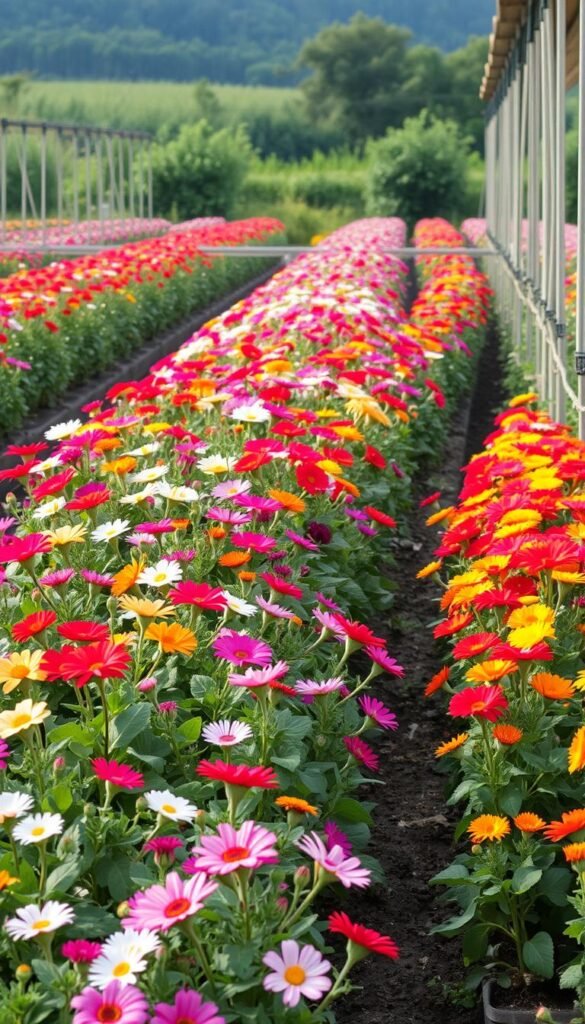
Revolutionize your floral production with methods that transform limited areas into blooming factories. SPIN farming – developed by Canadian innovator Wally Satzewich – turns tight spaces into profit centers through four powerhouse tactics. These strategies help urban growers harvest 50% more stems per season compared to traditional row planting.
SPIN Farming’s Core Strategies
Master these four methods to boost your harvests:
- Succession planting: Sow quick-growing varieties every 14 days (try calendula then zinnias)
- Intercropping: Pair tall sunflowers with low-growing alyssum
- Vertical growing: Train sweet peas up obelisks for 3x the blooms
- Intensive spacing: Place plants 25% closer than seed packets suggest
| Technique | Traditional Yield | SPIN Yield | Space Saved |
|---|---|---|---|
| Sweet Peas | 18 stems/sq ft | 42 stems/sq ft | 60% |
| Zinnias | 9 stems/sq ft | 15 stems/sq ft | 40% |
| Snapdragons | 12 stems/sq ft | 22 stems/sq ft | 55% |
Year-Round Harvests Made Simple
Stagger plantings using this formula: Start cool-season blooms like larkspur in early spring, then transition to heat-loving celosia. As summer peaks, plan your square foot garden for fall chrysanthemums. One Ohio grower shares: “We harvest bouquets 34 weeks yearly by planting in 2-week cycles.”
Bio-intensive methods keep soil thriving despite heavy use. Alternate deep-rooted dahlias with shallow pansies, and always add compost between plantings. You’ll create self-sustaining ecosystems that support constant growth while protecting your most valuable asset – healthy earth.
Layout Strategies for Limited Spaces and Vertical Options
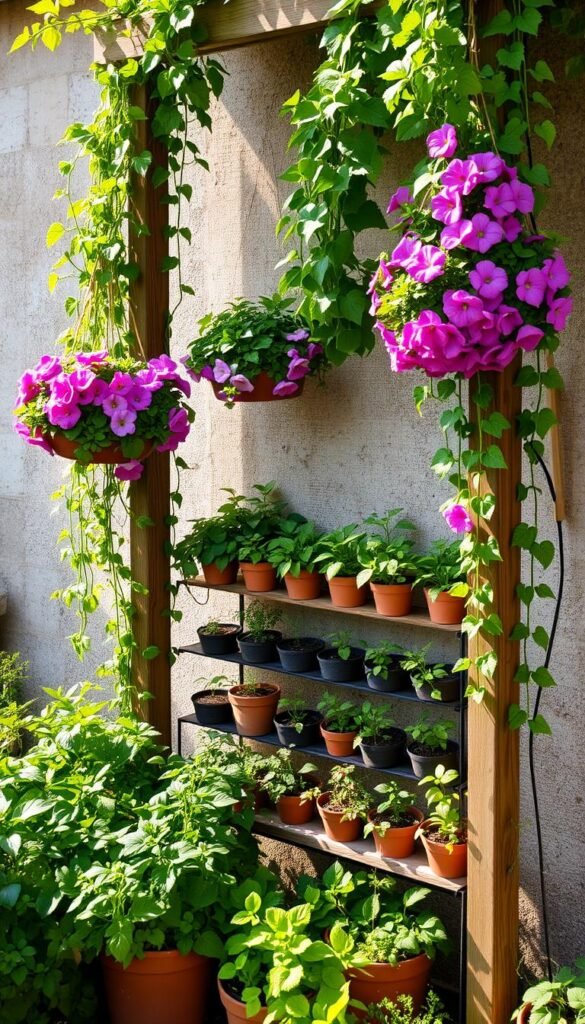
Unlock vertical potential when ground space feels restrictive. Urban growers in Brooklyn prove balconies can yield 50 stems weekly using smart stacking systems. One creative solution involves repurposing shoe organizers into cascading planters for trailing nasturtiums.
Embracing container and vertical gardening
Choose containers with depth for strong root development. Dwarf sunflower ‘Sunspot’ thrives in 12-inch pots, producing 18″ stems perfect for arrangements. For vining varieties like sweet peas, use 7×7-inch spacing in rectangular planters with trellises attached.
Three space-saving winners:
- Snapdragon ‘Chantilly’ – slender spikes in tight quarters
- Zinnia ‘Thumbelina’ – compact plants with 3″ blooms
- Lisianthus ‘Rosanne Brown’ – patio-friendly stems
Rotate containers seasonally for nonstop color. Start with pansies in spring, transition to cosmos in summer, then shift to ornamental kale for fall. A Chicago gardener shares: “My fire escape produces 15 bouquets monthly using this rotation method.”
| Container Type | Best Flowers | Yield per Season |
|---|---|---|
| Hanging Baskets | Petunias | 40 stems |
| Vertical Planters | Strawflowers | 25 stems |
| Window Boxes | Dianthus | 30 stems |
Mobility becomes your secret weapon. Shift pots to follow sunlight patterns or shelter delicate blooms during storms. Pair movable containers with permanent trellises for dynamic designs that adapt to your needs.
Soil Preparation and Landscape Fabric Essentials
Healthy blooms begin beneath the surface. Proper groundwork ensures your plants thrive while reducing maintenance. Let’s explore how to create ideal growing conditions without breaking your back.
Testing and amending your soil
Start with a simple jar test: Combine soil and water in a clear container. After shaking, let it settle for 24 hours. You’ll see distinct layers revealing your soil’s sand, silt, and clay composition.
Most flowering plants prefer slightly acidic soil (pH 6.0-6.5). Use these amendment strategies based on test results:
| Soil Type | Best Amendment | Application Timing |
|---|---|---|
| Clay | Coarse sand + compost | Spring/Fall |
| Sandy | Peat moss + manure | Early Spring |
| Loam | Leaf mold | Anytime |
Seasonal care makes a big difference. Many successful growers follow this pattern:
- April: Mix in fish compost (1″ layer)
- June: Side-dress with worm castings
- October: Apply shredded leaves as mulch
Landscape fabric can be useful but requires planning. Try temporary stakes first to finalize plant spacing. A Washington grower notes: “I waited three seasons before installing permanent fabric – glad I did, since my layout changed twice!”
For beginners, proper soil prep is the first step to success. Our gardening starter checklist covers essential tools and techniques. Remember – healthy earth grows vibrant blossoms season after season.
Ensuring Year-Round Blooms and Seasonal Transitions
Transform your patch into a perpetual bloom machine through smart timing and plant partnerships. By coordinating nature’s rhythms with strategic variety pairings, you’ll enjoy fresh stems from thaw to frost.
Nature’s calendar meets your creativity
Start spring with tulips and ranunculus as showstoppers, flanked by larkspur spires. When summer heat arrives, transition beds to zinnias and lilies. Overlap plantings by 2-3 weeks – sow sunflowers as peonies fade to maintain visual impact.
Try these dynamic duos:
Early sweet peas + late globe amaranth
Cool-season stock + heat-loving celosia
Spring bupleurum + autumn amaranth
Design with purpose across months
Mix textures and heights in every bed. Pair velvety dahlias with airy Queen Anne’s lace. Use mint or basil as fragrant fillers that pull double duty in kitchen and vase. “My arrangements improved when I stopped planting seasons separately,” shares a Maine grower.
Extend your harvest window with simple protections. Floating row covers add 4-6 weeks in fall. Cold frames shelter pansies through light snows. Track bloom times yearly to refine your schedule – nature’s patterns become your roadmap.
With thoughtful planning, your space becomes a living calendar. Each season brings new colors and forms, keeping arrangements fresh and your passion thriving. The real reward? Sharing nature’s ever-changing beauty with those you love.

